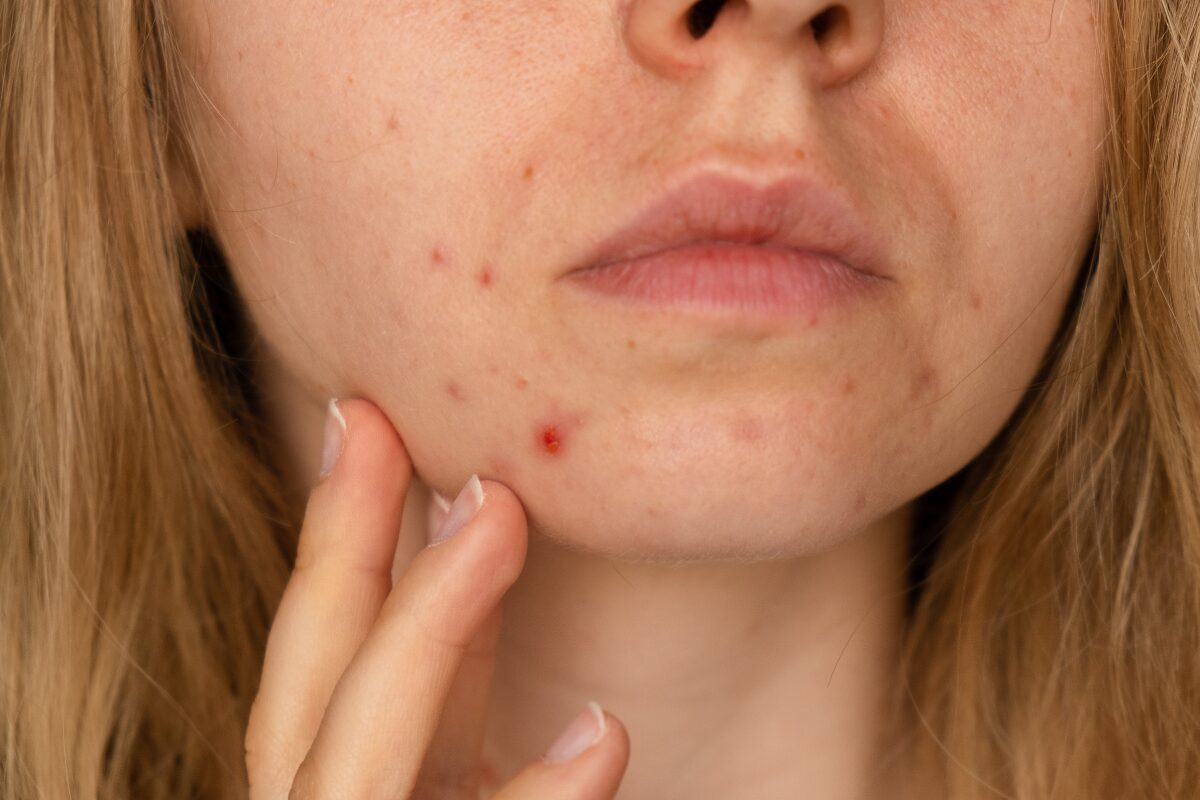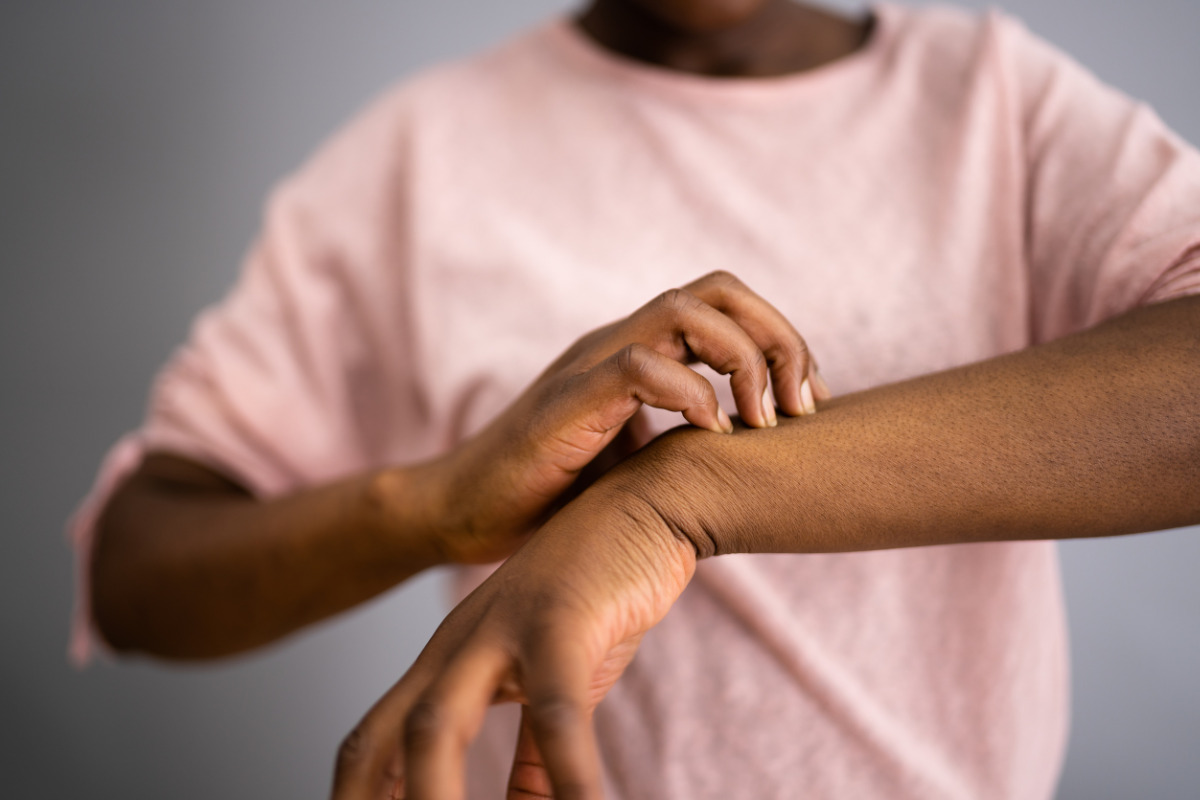Menopausal Acne: How to Deal With Midlife Breakouts

While you’re probably prepared for certain body changes in midlife, menopausal acne can catch many women off guard. We’ll explore why your fifties and sixties might start to feel like high school again—and discuss practical ways to manage your breakouts.
Does Menopause Cause Acne?
The main culprit behind most menopause symptoms is hormonal fluctuations and a sharp drop in estrogen levels. Testosterone levels decline more slowly with age. These changes create a situation where your body has relatively more testosterone than estrogen, which increases the likelihood of acne.
If you have been dealing with acne during your adult life, menopause-related acne may present differently than what you’re used to. However, if you previously always had problem-free skin, perimenopause may be the first time you’ve ever experienced acne.
The Role of Hormones
Estrogen helps keep your skin elastic and regulates oil production. Testosterone stimulates the skin to produce more oil. Excess oil, along with a slowdown in the production of new skin cells, creates an environment that promotes acne development.
Menopause also brings a decline in collagen production. Less collagen makes your skin less elastic, as well as making it more prone to inflammation and breakouts. Unfortunately, more sensitive skin after menopause may contribute to more redness and scarring after acne breakouts.
Lifestyle Factors and Skin
Menopausal life can be stressful, and that stress can make acne worse by increasing testosterone production. Your lifestyle, including your diet and sleep habits, also plays a role. It’s essential to address these factors to get a grip on menopausal acne.
Sun exposure, sleep deprivation, smoking, and obesity have also been shown to influence adult acne, and contribute similarly to menopausal acne.
How to Manage Menopausal Acne
Dealing with menopausal acne is about more than just skincare – it’s a holistic approach. During menopause, the skincare routine and products that served you well for years may won’t work as well or address your new skin issues. If you’ve had a particularly dramatic swing in skin type, your current skincare regimen may be entirely unsuitable.
Buying more and different products to deal with acne isn’t necessarily going to be effective. There’s a lot of hype, but not necessarily substance, around the latest ingredients. Spending more money on products doesn’t guarantee results, either. You need a multi-pronged approach.
Follow these practical steps to regain control.
1. Cleanse
Start your morning and evening skincare routine with a mild, hydrating cleanser. Even if you are not wearing makeup, wash your skin to remove accumulated dirt and pollution. Avoid harsh products that can strip the skin of essential moisture, as this may trigger the skin to produce more oil in compensation.
2. Exfoliate – Gently
It’s tempting to do more when your skin stops behaving the way that you want it to. However, scrubs, masks, and exfoliants all dry out skin and affect its moisture barrier. Lose your moisture barrier and you lose your skin’s protective barrier that keeps moisture in and the environment out. If you’re experiencing redness, dryness, itchiness, breakouts, or peeling, it’s time to give your skin a break.
This doesn’t mean that you can’t use drying products, but do so sparingly. Try an AHA-based chemical exfoliant a maximum of once per week followed by a hydrating sheet mask.
3. Moisturize Regularly
Moisturizing is crucial, even for those with acne-prone skin, as it helps maintain a healthy skin moisture barrier and prevent excessive oil production. Look for moisturizers with hyaluronic acid, which holds 1,000 times its own weight in water. It draws in moisture, so is ideal for hydrating the skin and giving you back your glow. Always moisturize after cleansing and any exfoliating treatment.
4. Use Sun Protection
Shield your skin from the sun’s harmful rays by using a broad-spectrum sunscreen. Sun protection is crucial, especially when using acne treatments that may increase sensitivity to sunlight. Use a moisturizer with a broad spectrum SPF of 30 or higher daily, and don’t forget to protect your neck and chest.
Look for mineral sunscreens with an SPF of 30 or higher that are made with zinc oxide and titanium dioxide. You can avoid the slight white cast of these products by looking for tinted versions.
These “physical” sunscreens are different than the “chemical” sunscreens made with ingredients that may irritate the skin on your face. While there is no conclusive evidence, some research shows that the ingredients in chemical sunscreens can have negative health effects.
5. Consider Topical Treatments
Topical treatments containing ingredients like retinoids, benzoyl peroxide or salicylic acid can can help unclog pores and promote cell turnover. More is not better, however. These topicals dry out and irritate skin, so it’s essential to use sun protection and lots of moisturizer to avoid making mature, sensitive skin worse. Options like azelaic acid are more mild, and generally easier to tolerate.
6. Read Your Product Labels
Some makeup, along with many skin and hair care products, contain oil or other ingredients that can cause acne breakouts. If you continue to use them, you may continue to see blemishes. Look for oil-free makeup products and stay away from common pore-clogging ingredients in hair products, including sodium lauryl sulfate, sodium coco sulfate, and sodium laureth sulfate.
7. Maintain a Healthy Lifestyle
Embrace a balanced diet rich in antioxidants, vitamins, and minerals. Regular exercise and stress management techniques can also contribute to overall skin health.
Research shows that chronic poor sleep is associated with increased signs of skin aging like fine lines and loss of elasticity, as well as a less robust skin moisture barrier. It seems that sleep helps all the body systems, including your skin, recover from the stresses of your day. Need help with your sleep? Start with Midday’s guided sleep program.
8. Drink Water
In a 2015 study, women who drank an extra 2 liters of water per day on top of their normal fluid intake had significant increases in superficial and deep skin hydration after four weeks. Those who previously had lower water intake had even greater benefits than those who typically drank more. The authors write that increasing dietary water intake affected the skin the same way as a topical moisturizer.
Adult women should aim for a total of 2.7 liters of water per day, including water from food. When was the last time you tracked your water intake? Keep a diary for a few days to see where your water intake stands.
9. Consult a Dermatologist
If menopausal acne is giving you a tough time, don’t hesitate to consult a dermatologist. They can provide personalized recommendations and may prescribe prescription topical or oral medications, or other treatments tailored to your skin’s needs.
10. Consider Hormone Therapy
Oral contraception (hormonal birth control) or Menopausal Hormone Therapy (MHT) may be a good option for managing menopausal acne. Hormonal medication can help balance out the hormonal shifts that cause acne, as well as other perimenopause or menopause symptoms. Discuss the risks and benefits of these options with your healthcare provider to determine if they’re appropriate for your goals and medical history.
Menopausal acne may be a surprise guest, but you can meet the challenge with a proactive approach and enjoy healthy, radiant skin well past menopause. Adopt a skincare routine that suits you, and reach out for professional help when needed.
You’re not alone in this journey – for more tips on managing menopause symptoms and healthy aging, visit us at Midday.Health.
Sign up for more unique women’s health content
By submitting this form, you agree to the Lisa Health Privacy Policy and Terms of Use


